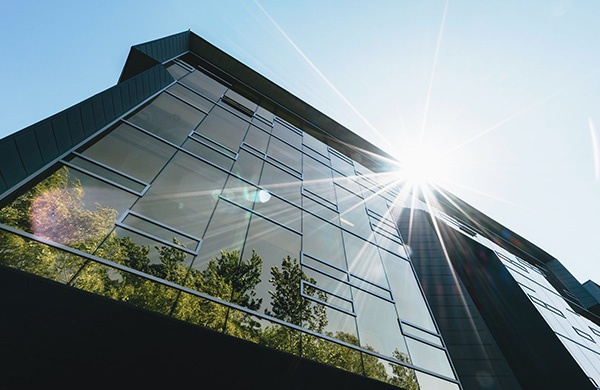By Christine McEntee | American Institute of Architects
Sustainable design as a business strategy is not just cost effective; it' s essential for the achievement of today' s needs without sacrificing the resources of future generations.
Sustainable principles for the design, construction, and renovation of homes and buildings are imperatives that will yield economic, health, and most importantly, environmental benefits. In terms of lowering the ecological footprint of the built environment, the lion's share of media attention and legislative focus has thus far centered on automobiles and alternative fuel sources. Both areas are important when developing strategies to help mitigate climate change, but they're not the largest contributors of greenhouse gas (GHG) emissions. That burden falls on homes and buildings.
The Impact of Buildings
Buildings and the embedded energy within their interiors account for an estimated 48 percent of all GHG emissions, far more than transportation (27 percent) and industry (25 percent). To boot, 71 percent of all electricity generated by power plants goes toward operating buildings. Homes and buildings in the United States account for nearly the same amount of carbon emissions as the economies of Japan, France, and the United Kingdom combined. If current trends continue, annual energy consumption in the United States is expected to increase by 37 percent over the next twenty years. During that same time frame, GHG emissions from buildings are expected to rise by 36 percent. But here's where the tide can turn: by 2035, three-quarters of the buildings in the United States will be new or significantly renovated, allowing for a radical change in thinking and design.
The Barrier of Cost
In December 2007, the McKinsey & Company consulting firm released a report titled "Reducing U.S. Greenhouse Gas Emissions: How Much at What Cost?" It examined the cost of five different initiatives that could significantly lower GHGs through whatever changes would be necessary to reduce the carbon emissions from automobiles, industrial plants, electrical power sources, and carbon sinks. The initiatives determined that improving the energy efficiency in buildings and appliances would have the lowest average cost of any area. "This largest cluster of negative cost options included lighting retrofits; improved heating, ventilation, and air conditioning systems; building envelopes and building control systems; and use of efficient consumer and office electronics and appliances."
Conclusion
There are, of course, challenges to making sustainable design the norm. The perceived extra cost of designing a more energy-efficient, sustainable building is the primary barrier, especially for those who don't plan to own or occupy the building over its lifespan. But the costs are often lower than they're feared to be. According to the U.S. Green Building Council (USGBC), upfront additional costs are just 1.84 percent higher than those of traditional design. According to a Capital E report called "Greening America's Schools", active green schools offer financial benefits twenty times greater than their initial cost, allowing for an average savings of $100,000 a year.
Health Benefits of Going Green
Benefits of sustainable design for businesses go beyond economics; they also relate to improved health and increased productivity for the inhabitants of green buildings. SmartRisk, a risk management solutions provider for the real estate industry, estimates poor business design costs between $29 billion and $168 billion in lost productivity every year. Luckily, many companies now place a premium on sustainable and innovative design for their workplaces as a way to bolster employee satisfaction and efficiency, lower turnover and absenteeism, and represent an extension of their corporate brand. Green buildings also have improved indoor air quality, which in turn helps reduce asthma, flu, sick building syndrome, headaches, and respiratory problems that can lead to missed time from work or school, chronic illness, and potential lawsuits.
The Big Picture
It's not just homes and buildings that need to have eco-friendly design elements; the same principles should apply to communities and neighborhoods across the country. Homeowners are now looking for options to help offset rising utility costs and longer commutes. As such, they want to live in places designed to include better access to public transportation, recreation, and commercial and entertainment. Mixed-use developments, where residential units blend with retail, dining, and other commercial activities, lead to a more vibrant city and one that is less reliant on the automobile. They work especially well if easy access to open spaces, walkways, athletic fields, and bike paths is emphasized.
According to Richard Jackson, adjunct professor of public health at UC Berkeley, the health challenges of the twenty-first century relate to an aging population and a lack of physical fitness. That population is also prone to more chronic diseases, especially obesity, diabetes, and depression.
Jackson says well-designed spaces support vigorous living in walkable communities and active socializing in healthy places of the heart. He feels architects, builders, planners, and developers must be included among today's important health leaders.
The Call for Leadership
The government is in the best position to advocate for eco-friendly, energy-efficient practices through legislation. A combination of mandates and incentives could rapidly accelerate the adoption of green-building practices in commercial and residential sectors alike.
The design and construction industries have embraced sustainable design meeting the increased demand coming from clients and homeowners. There are encouraging signs on many fronts, but we are still a long way from reaching the green goal of the American Institute of Architects (AIA): reducing carbon emissions from buildings by 50 percent come 2010 and achieving carbon neutrality come 2030. The U.S. Conference of Mayors and the National Association of Counties both support this endeavor, and the AIA has made resources available for clients and design professionals to help educate the marketplace on the benefits of sustainable design. Architects are leaders and problem solvers who help to make sustainable design the norm in the design and construction industries. They should start by regularly measuring the carbon footprint of their projects and becoming adept at using Building Information Modeling technologies that allow for greater collaboration within a project team and help eliminate waste and inefficiency in the construction process. Now's the time to capitalize on the increased exposure environmental concerns have received and translate awareness into action. It's time for industry, government, and the general public to form the next green wave.
About PE Facility Solutions
PE Facility Solutions, LLC, now under the brand Pristine Environments, manages, maintains and optimizes the performance of mission critical facilities for corporate real estate owners in nearly 100 million square feet of specialized buildings throughout North America. With a broad range of experience across an array of industries, including life sciences/cleanrooms, aerospace, datacenters, oil & gas, luxury retail, sports technology & fitness, and commercial real estate, our organization of over 1,000 professionals keeps our customers’ buildings and facilities operating efficiently, sustainably and on budget.



